There is one British export that is worth its weight in gold. Warhammer 40,000 (40k for short) is among the best science fiction stories ever written. Luckily for us it is also a game. If you're not familiar with the game then where do I begin? Imagine trying to explain the Star Wars Trilogy to someone that has never seen it. How do you talk about the Force, Darth Vader and the Emperor? Where do you bring in Luke Skywalker and Ben Keobi? The best bet would be to explain the universe as it happened (beginning with episode IV). So that's what I'll try to do.
40k is not set in the continuity of WH. It is the far future and humans managed to get to the farthest reaches of space using the Warp. The Warp is sort of like a series of semi-sentient, turbulent, interconnected wormholes. Although humans can navigate the Warp via enormous starships, the pull of Chaos sometimes corrupts the stream and millions are lost forever in the hyper-space tempests. At the same time humanity is splintered into warring nations and struggling to survive, causing those on the farthest planets to lose contact with Earth. The Emperor of Mankind is from Terra (Earth).
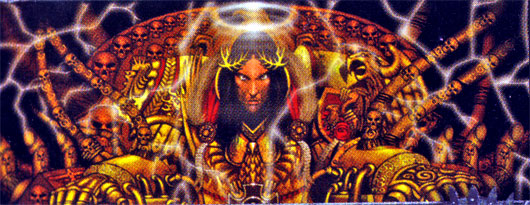
There is a great summary on Wikipedia. He was born with extraordinary powers, he is tall, very strong and super-intelligent and to top if off he is the most powerful psychic force that has ever existed. Professor X and Jean Grey from the Marvel universe and Neo from the Matrix do not even compare. The Emperor unites humanity and begins what can only be described as a renaissance. He sets about to reestablish contact with the lost human colonies and spread civilization throughout the rest of the galaxy. In order to protect humanity from aliens he creates the strongest fighting force Terra has ever known. Using his own genetic material as a template he creates the Primarchs, the founding fathers of what would become the Space Marines.
The forces of Chaos sensed what the Emperor was up to. When the Primarchs left Terra (in incubation chambers) they forced the ships to become lost in the Warp and be scattered across the galaxy. The Emperor went on several crusades to recover his sons and with them create the chapters of the Space Marines. Eventually his legions go forth and conquer in the name of Terra. Humanity is set to continue for a millennia thanks to the contributions of the Emperor.
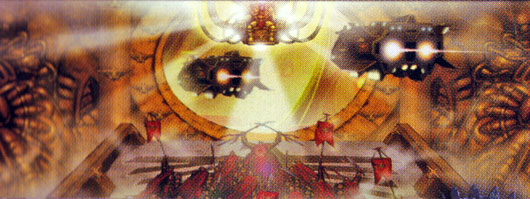
From his Golden Throne on Terra, the Emperor is able to harness his powers and create wormholes to send his troops anywhere through the cosmos. Even the most powerful psychers can only last a few moments on the throne before they shrivel up and die. The Emperor was able to to do this without breaking a sweat and beam his light, like a beacon, to the furthest reaches of space and guide wayward starships home. All of his legions were loyal to Terra. Humanity had expanded during his reign further than it had in ten thousand years. That was until the forces of chaos began to seduce a good number of his legions and Primarchs, including the Emperor's favorite son and warmaster Horus. Pictured here are the Emperor, Sanguinus the founder of the Blood Angels who was born with wings (and remained loyal) and the traitor Horus.
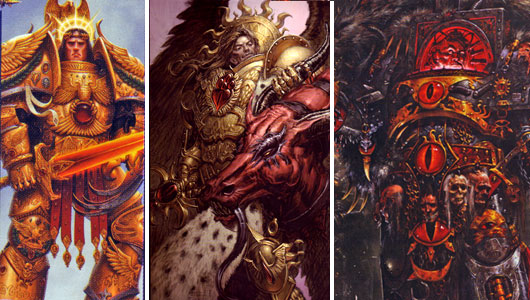
The seductive powers of chaos proved too hard to resist. Those smitten by temptation slowly begin their transformation until the most powerful primarchs become demon princes, like Fulgrim the founder of the Emperors Children.
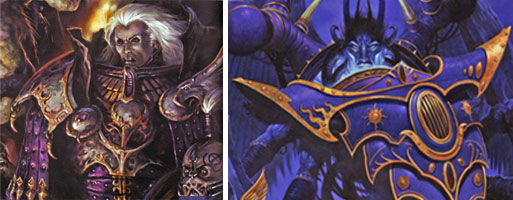
About half of the Emperor's legions secretly turned to service of the dark gods and rebeled against him when his forces were stretched thin. The time is known as the Horus Heresy. The results of which were tragic and everlasting.
British science fiction design is unique compared to the rest of the world. In Japan science fiction design is clean and tight. Robots are sleek, their weapons seamless and technology superior to anything out there. In the USA, science fiction is a little more tangible thanks to the work of studios like Industrial Light and Magic. The designs and science featured in USA television and movies are a little easier to believe. The Brits are unlike either countries with their approach. British design can be either crude by comparison, case in point the Dalek's in Dr. Who, or ahead of their time, think Gerry Anderson's designs for the Thunderbirds and Space 1999.
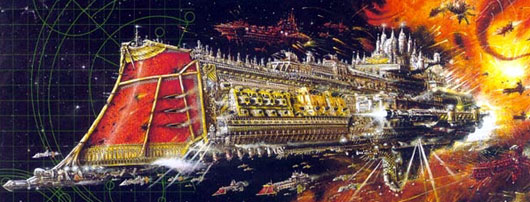
The design that goes into 40k is unlike anything you've seen before. Everything from robots, to starships, weapons and armor are very Gothic (as in architecture, not pasty-faced emo crap), almost Baroque. The faces of the gigantic ships and enormous titan robots are adorned with sharp columns and flying buttresses (stop laughing Smashbro!). The largest of the vehicles and space stations look like cathedrals, where the Space Marines converge, receive their litanies and prepare for battle. The process of becoming a marine is very religious. At each step they are tested and purified of chaos, the armor that each marine receives and the weapons themselves are treated like holy relics. Some of these weapons and craft are indeed ancient.
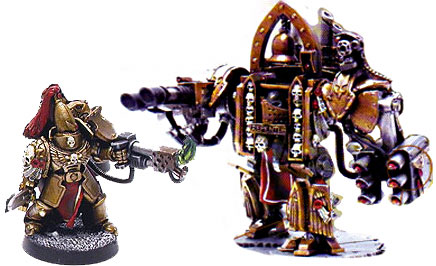
Wait a sec, why is that?
After the Horus Heresy there was pretty much a stop to the progress the Emperor begat. This includes the advances in science and weaponry. Humanity almost fell back into the "dark ages" and would have if not for those loyal to the Emperor himself. They insisted that the Space Marines continue their crusades to rid the galaxy of chaos but with smaller numbers than ever before. What was sickening to humanity were the powers of chaos. The primarchs seduced by chaos became demons, their legion became corrupt shadows of their former selves. One of the armies that fell the furthest were the Thousand Sons, their pre-heresy armor had an Egyptian motif. When they turned to chaos their armor sealed and trapped their immortal souls within. Making this not only one of the most unique armies in 40k but also one of the best modeled and painted. Check out these pre and post heresy figures.
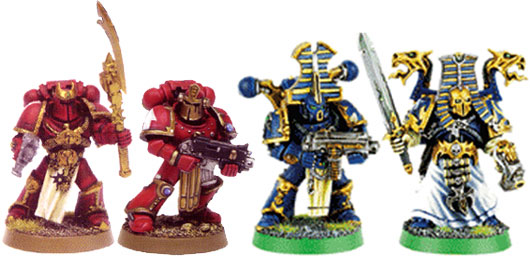
The pull of chaos was so great that it not only turned man against man, but it also twisted machines into abominations.

Tanks were covered with the dead and damned, even once venerable robots with Space Marine heroes as their brain and heart, the Dreadnought, would be twisted into spider-monsters called Defilers.
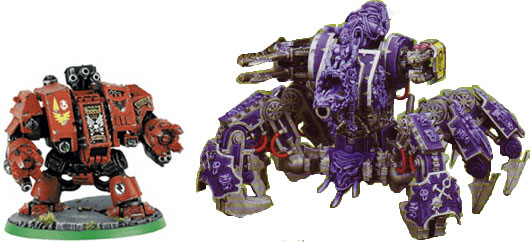
The Forge Worlds that created most of the technology were sequestered by the Inquisition and signed a treaty to show their allegiance to the Emperor. The Forge Worlds, including the home base on Mars are almost completely autonomous of the Empire, the factories are run by the Adeptus Mechanicus who worship the Machine God rather than the Emperor. These Forge Worlds do not crank out new weapons as quickly as they once did. This is because the factories that were not destroyed lost most of their technology in the wars. Surviving armor and designs are revered and taken care of by Tech Marines.

The final battle against Horus happened in outer-space, aboard the warship of Horus. The fight was so intense that space and time warped around Horus and the Emperor himself. While their physical bodies fought, their psychic selves battled and even their souls combated on infinite planes of reality. Growing up reading this my brothers and I were amazed at the battle, this is a level of combat that Son Goku or Superman could never reach. In the end, or should I say the beginning of 40k, the Emperor defeated Horus. But his body was shattered and on the verge of death. So the Emperor ordered that he be placed on his Golden Throne, where he would be connected to machinery and kept on the brink of death for all time. His remaining psychic power would remain there and forever seal the portal to Terra, preventing the chaos energies or rogue armies from invading again. Sadly this would be the end for a god that walked among men.
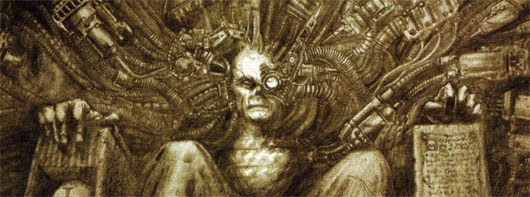
The aliens of 40k are mirrored from the Warhammer world. The Elves are called Eldar, the Orcs are Orks and the Tomb Kings are actually robotic skeletons, the remains of an ancient race called the Necrons. There aren't future version of Skaven or Lizardmen however, as much as I wish there were. There are new challenges however in the voracious Tyranid, an alien species that devours and then assimilates everything they come across. Then there are the Tau (C'tan), a young but very advanced alien group whose design and technology can be considered the closest to Japanese mecha.
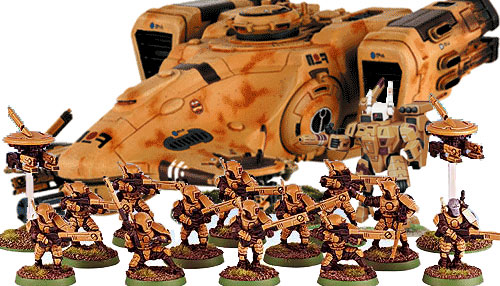
The Space Marines are not alone in these battles. While they are genetically engineered super-soldiers (complete with extra organs), their ranks have been steadily decreasing over the years. The Imperial Guard are as close to our concept of traditional soldiers as you will find. While they are not as big as their Marine counterparts, the Imperial Guard have access to the largest artillery. There is also an all-female wing of troops known as the Sisters of Battle, they work for the ecclesiarchy and hunt down heretics and rogue psychers. There are also Demonhunters that purge the cosmos of the chaos and alien influence. On rare occasion the human forces have been known to side with the Eldar, like the elite "Harlequins" below.
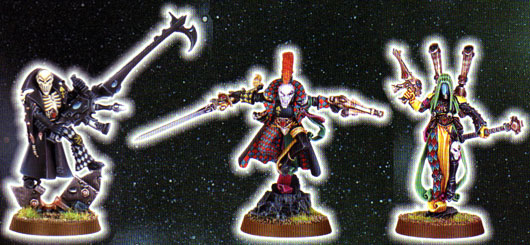
For the most part humanity is left up to its own devices. There are far more enemies than allies for humanity as 40Kk is explained in Penny Arcade. For the gamers that don't want to play a large-scale battle with either WH or 40k they have options. WH has a small skirmish game called Mordheim and 40k has one called Necromunda. Both games are set in the bleak places of their respective universes. Mordheim in a town of sin and debauchery that gets struck by a twin-tailed comet. In the remains of the city there are battles between the various races of WH with no more than a handful of characters at a time. In Necromunda the skirmish battles are between futuristic gangs vying for power in the "hive," or mega cities of densely populated planets. Both games allow for unique scenarios that would be too difficult to accomplish in WH or 40k.
So let's look at the big picture again. Step back and study how all the races wage war, what do these games look like? For reference check out Warhammer 40,000, Dawn of War. Fans of WarCraft often become fans of Blizzard's science fiction series StarCraft... I bet you see what I'm getting at. Warhammer is to WarCraft what Warhammer 40k is to StarCraft. It's kind of hard to explain it to videogamers that aren't familiar with tabletop systems. For example read the first paragraph on how Tycho has to explain the 40K MMO to Gabe. Heck, during the hype of StarCraft, Wizards of the Coast was looking at licensing a miniatures-based game for them. Hmm, shall we compare the StarCraft models to 40k ones?

Above are some 40K minis including Space Marines, Space Marines in Terminator armor and Sisters of Battle. Below those from StarCraft.
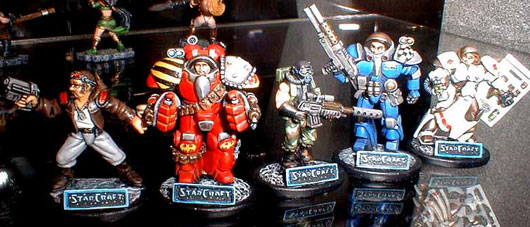
How about some Tyranid aliens?
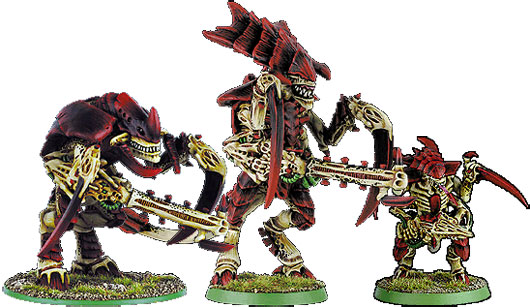
And those whatchamacallits from StarCraft.
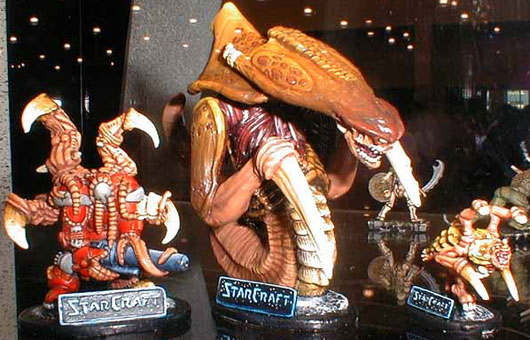
Maybe some Tau, Necron and Kroot aliens?
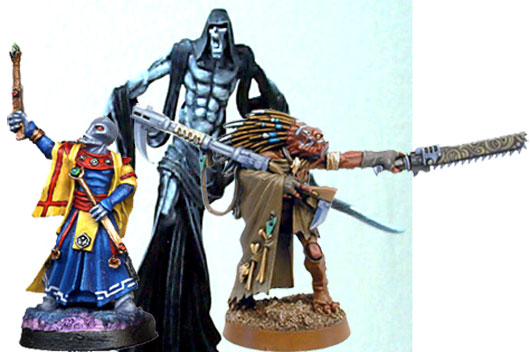
Yeah right...
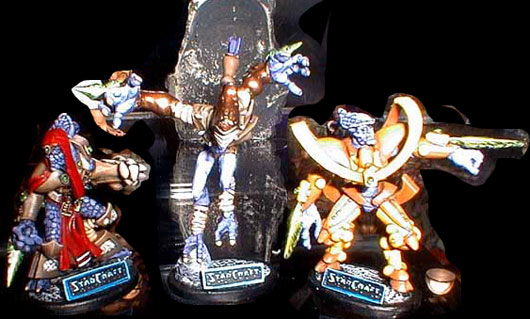
Too bad Games Workshop had nothing but crappy videogame licenses up until now or else the world would be very different. There is more for you tomorrow, including the reasons why I hate Games Workshop almost as much as I love them!

4 comments:
You have to remember that Games Workshop is wayyyy older than WarCraft and StarCraft... So probably WH and WH40k was inspiration for Blizzard while making WarCraft and StarCraft. I love GW for awesoem universe that they created. But i hate them for how expensive thei miniatures are :P
Alright. This is somewhat late.
There are some factual errors in your explanations. If you are explaining things like this and actually want to relay information, relay the right information.
Minor objections before full scrutiny:
The Emperor didn't create the Chapters after finding the Primarchs.
The Space Marines were created from previous research of the Primarchs, in their abscense.
The Emperor created Legions, the Chapter system is not introduced until after the Emperors "demise" and is an institution created by Roboute Guilliman (Ultramarines Primarch).
oi!
Starcraft and Warcraft where made after warhammer and warhammer 40k.
Some guys that made warhammer and 40k left, but they held part of the copyright. So they went out and made startcraft and warcraft basing them of the same sorta stuff.
Dont yell at games workshop for stealing the ideas.
TSR Dungeons and Dragons 1974
GamesWorkshop 1975
-Rogue Trader-
Warhammer Fantasy Battles (tabletop) 1983
Warhammer 40,000 (tabletop) 1987
Blizzard Ent 1991
Warcraft 1994/6 (MS-DOS/Macintosh)
Starcraft 1998 (pc)
google lexicanum to get the facts straight.
Post a Comment